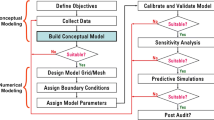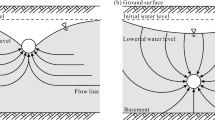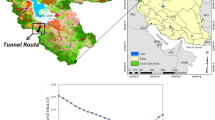Abstract
In order to prevent problems like casualties, delays in tunneling procedure, and increasing tunneling costs, predicting groundwater inflow into tunnels and designing an efficient drainage system are necessary. Several analytical solutions exist in the literature, but they cannot accurately estimate groundwater inflow due to simplifying assumptions. Numerical methods, however, are increasingly used to predict groundwater inflow with higher accuracy. This study is aimed at predicting the steady state groundwater ingress into Tabriz line 2 metro tunnel (TML2: a shallow urban tunnel) by considering model dimensions as critical factors in the numerical analysis process. A 2-D numerical finite element analysis of steady state groundwater inflow was performed along the tunnel based on geological and geotechnical investigations. Water inflow into TML2 was then estimated based on optimum model dimensions. The total amount of groundwater inflow into TML2 was estimated to be 7013.6 l/min. The maximum cumulative water inflow into the tunnel was also predicted to occur between 15.55 and 16.25 km in the tunnel with a 4754 l/min inflow rate, which demands an effective drainage program. Finally, for validation of the methodology groundwater inflow values obtained through 2D finite element analysis were compared to those calculated with a well-known inflow evaluation method (Raymer solution).









Similar content being viewed by others
References
Aalianvari A (2014) Optimum depth of grout curtain around pumped storage power cavern based on geological conditions. Bull Eng Geol Environ 73:775–780. doi:10.1007/s10064-013-0550-z
Aalianvari A, Maleki Tehrani M, Soltanimohammadi S (2013) Application of geostatistical methods to estimation of water flow from upper reservoir of Azad pimped storage power plant. Arab J Geosci 6(7):2571–2579. doi:10.1007/s12517-012-0528-3
Aryafar A, Doulati Ardejani F, Singh RN, Jodeiri Shokri B (2007) prediction of groundwater inflow and height of the seepage face in a deep open pit mine using numerical finite element model and analytical solutions. In: Cidu R, Frau F (eds) Proceedings of the water in mining environments symposium. Cagliari, Italy, pp 313–317
Aryafar A, Doulati Ardejani F, Singh RN (2009) Numerical modeling of groundwater inflow from a confined aquifer into Sangan open pit mine, northeast of Iran. Int J Geomech Geoeng 4(3):189–198. doi:10.1080/17486020902919138
Asghari-Kaljahi E, Yousefi-Bavil K, Babazadeh M (2015) A study of ground natural temperature along Tabriz metro line 2, Iran. In: Lollino et al. (ed) Engineering geology for society and territory, vol 6. Springer International Publishing, pp 295–298. Doi:10.1007/978-3-319-09060-3_49
Bahrami S, Doulati Ardejani F, Aslani S, Baafi E (2014) Numerical modelling of the groundwater inflow to an advancing open pit mine: Kolahdarvazeh pit, Central Iran. Environ Monit Assess 186:8573–8585. doi:10.1007/s10661-014-4025-x
Berkowitz B (2002) Characterizing flow and transport in fractured geological media: a review. Adv Water Resour 25(8–12):861–884. doi:10.1016/S0309-1708(02)00042-8
Bobet A (2010) Numerical methods in geomechanics. Arab J Sci Eng 35:27–48
Butscher CH (2012) Steady-state groundwater inflow into a circular tunnel. Tunn Undergr Space Technol 32:158–167. doi:10.1016/j.tust.2012.06.007
Chapuis RP (2011) Steasy state groundwater seepage in sloping unconfined aquifers. Bull Eng Geol Environ 70:89–99. doi:10.1007/s10064-010-0282-2
Coli M, Pinzani A (2014) Tunneling and Hydrogeological issues: a short review of the current state of the art. Rock Mech Rock Eng 47:839–851. doi:10.1007/s00603-012-0319-x
Doulati Ardejani F, Singh RN, Baafi EY, Porter I (2003a) A finite element model to: 1. Predict groundwater inflow to surface mining excavations. Mine Water Environ 22:31–38. doi:10.1007/s102300300005
Doulati Ardejani F, Singh RN, Baafi EY, Porter I (2003b) A finite element model to: 2. Simulate groundwater rebound problems in backfilled open cut mines. Mine Water Environ 22:39–44. doi:10.1007/s102300300006
El Tani M (1999) Water inflow into tunnels. In: Proceedings of the world tunnel congress ITA-AITES, Balkema, Oslo, pp 61–70
El Tani M (2003) Circular tunnel in a semi-infinite aquifer. Tunn Undergr Space Technol 18:49–55. doi:10.1016/S0886-7798(02)00102-5
El Tani M (2010) Helmholtz evolution of a semi-infinite aquifer drained by a circular tunnel. Tunn Undergr Space Technol 25:54–62. doi:10.1016/j.tust.2009.08.005
Farhadian H, Aalianvari A, Katibeh H (2012) Optimization of analytical equations of groundwater seepage into tunnels, A case study of Amirkabir tunnel. Geological Society of India 80:96–100. doi:10.1007/s12594-012-0122-z
Fernandez G, Moon J (2010) Excavation-induced hydraulic conductivity reduction around a tunnel, part 1: guideline for estimate of ground water inflow rate. Tunn Undergr Space Techn 25(5):560–566. doi:10.1016/j.tust.2010.03.006
Font-Capó J, Vázquez-suñé E, Carrera J, Martí D, Carbonell R, Pérez-Estaun A (2011) Groundwater inflow prediction in urban tunneling with a tunnel boring machine (TBM). Eng Geol 121:46–54. doi:10.1016/j.enggeo.2011.04.012
Freeze RA, Cherry JA (1979) Groundwater Englewood. Prentice-Hall Inc, TIC, New Jersey 217571
Garzonio CA, Piccinini L, Gargini A (2014) Groundwater modeling of fractured aquifers in mines: the case study of Gavorrano (Tuscany, Italy). Rock Mech Rock Eng 47(3):905–921. doi:10.1007/s00603-013-0444-1
Geological survey of Iran (1993) Tabriz Geology map. Scale 1(100):000
Geo-Slope International Ltd (2007) Seep/w software package for finite element seepage analysis. http://www.geoslope.com/products/seepw.aspx
Goodman R, Moye D, Schalkwyk A, Javendel I (1965) Groundwater inflow during tunnel driving. Eng Geol 1:150–162
Heuer RE (1995) Estimating rock-tunnel water inflow. In Proceeding of the rapid excavation and tunneling conference, pp 18–21
Holmøy KH, Nilsen B (2014) Significance of geological parameters for predicting water inflow in hard rock tunnels. Rock Mech Rock Eng 47:853–868. doi:10.1007/s00603-013-0384-9
Huangfu M, Wang M, Tan Z, Wang X (2010) Analytical solutions for steady seepage into an underwater circular tunnel. Tunn Undergr Space Technol 25(4):391–396. doi:10.1016/j.tust.2010.02.002
Hwang JH, Lu CC (2007) A semi-analytical method for analyzing the tunnel water inflow. Tunn Undergr Space Technol 22(1):39–46. doi:10.1016/j.tust.2006.03.003
Indraratna B, Ranjith P (1998) effects of boundary conditions and boundary block size on inflow to an underground excavation—sensitivity analysis. In: IMWA Proceedings, Johannesburg
Jing L (2003) A review of techniques, advances and outstanding issues in numerical modelling for rock mechanics and rock engineering. Int J Rock Mech Mining Sci 40:283–353. doi:10.1016/S1365-1609(03)00013-3
Jing L, Hudson JA (2002) Numerical mthods in rock mechanics. Int J Rock Mech and Mining Sci 39:409–427. doi:10.1016/S1365-1609(02)00065-5
Karlsrud K (2001)Water control when tunneling under urban areas in the Olso region. NFF publication No. 12, 4, 27–33, NFF
Kolymbas D, Wagner P (2007) Groundwater ingress to tunnels—the exact analytical solution. Tunn Undergr Space Technol 22:23–27. doi:10.1016/j.tust.2006.02.001
Kong WK (2011) Water ingress assessment for rock tunnels: a tool for risk planning. Rock Mech Rock Eng 44:755–765. doi:10.1007/s00603-011-0163-4
Lei S (1999) An analytical solution for steady flow into a tunnel. Ground Water 37:23–26. doi:10.1111/j.1745-6584.1999.tb00953.x
Li D, Li X, Li CC, Huang B, Gong F, Zhang W (2009) Case studies of groundwater flow into tunnels and an innovative water gathering system for water drainage. Tunn Undergr Space Technol 24(1):260–268. doi:10.1016/j.tust.2008.08.006
Lombardi G (2002) quoted from: El Tani M (2003) Circular tunnel in a semi-infinite aquifer. Tunneling and Underground Space Technology 18:49–55. doi:10.1016/S0886-7798(02)00102-5
Mikaeil R, Doulati Ardejani F (2009) Prediction of groundwater inflow into tunnels using numerical models; a practical case study: Kuhin railway tunnel, Qazvin-Rasht, Iran. Int J Eng Sci 19(9):65–73 (in persian)
Nikvar Hassani A (2014) Asessment of groundwater inflow into Tabriz Line 2 metro tunnel. M.Sc. thesis, Amirkabir University of Technology (Tehran Polytechnic)
Park K, Owatsiriwong A, Lee JG (2008) Analytical solution for steady-state groundwater inflow into a drained circular tunnel in a semi-infinite aquifer: a revisit. Tunn Underg Space Technol 23:206–209. doi:10.1016/j.tust.2007.02.004
Perrochet P (2005) Confined flow into a tunnel during progressive driling: an analytical solution. Ground Water 43(6):943–946. doi:10.1111/j.1745-6584.2005.00108.x
P.O.R Consulting Engineers (2011) Geotechnical investigation of TML2 project
Raymer JH (2001) Predicting groundwater inflow into hard-rock tunnels: Estimating the high-end of the permeability distribution. In: Proceedings of the rapid excavation and tunneling conference. Society for Mining, metallurgy and exploration, Inc
Samardzioska T, Popov V (2005) Numerical comparison of the equivalent continuum, non-homogeneous and dual porosity models for flow and transport in fractured porous media. Adv Water Resour 28(3):235–255. doi:10.1016/j.advwatres.2004.11.002
Sharifzadeh M, Karegar S, Ghorbani M (2013) Influence of rock mass properties on tunnel inflow using hydromechanical numerical study. Arab J Geosci 6:169–175. doi:10.1007/s12517-011-0320-9
Soni AK, Manwatkar B (2015) Seepage modeling for a large open pit coal mine in India. Geotech Geol Eng. doi:10.1007/s10706-015-9881-9
Zarei HR, Uromeihy A, Sharifzadeh M (2011) Evaluation of high local groundwater inflow to a rock tunnel by characterization of geological features. Tunn Undergr Space Technol 26:364–373. doi:10.1016/j.tust.2010.11.007
Acknowledgments
The authors wish to thank the support of the mining and metallurgical engineering department of Amirkabir University of Technology (Tehran Polytechnic). The technical support given by the Tabriz Urban Railway Organization (TURO) is acknowledged. The authors also would like to thank the great and sincere cooperation of Rasoul Aftabi in TURO. Finally, many thanks to the anonymous reviewers for their constructive and valuable comments.
Author information
Authors and Affiliations
Corresponding author
Rights and permissions
About this article
Cite this article
Nikvar Hassani, A., Katibeh, H. & Farhadian, H. Numerical analysis of steady-state groundwater inflow into Tabriz line 2 metro tunnel, northwestern Iran, with special consideration of model dimensions. Bull Eng Geol Environ 75, 1617–1627 (2016). https://doi.org/10.1007/s10064-015-0802-1
Received:
Accepted:
Published:
Issue Date:
DOI: https://doi.org/10.1007/s10064-015-0802-1




